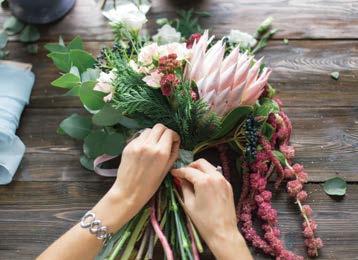
14 minute read
EYE CARE FOR KIDS
For roughly $3 PER DAY you can start marketing your business!
Reach 25,000 TARGETED* BuxMont readers per month with our Resource Guide.
*TARGETED: 100% of the people seeing your message are interested in health and wellness.
CATEGORY NAME
YOUR BUSINESS NAME Contact Name Address, City Phone • Website URL Description: 40 words. Extra words and info lines available. The Resource Guide listings are a reference tool allowing our readers to find you when they need you. Special pricing for display advertisers. Page number of your display ad here (if applicable).
FOR NO ADDITIONAL CHARGE, YOU WILL RECEIVE: One Newsbrief every six months
(your opportunity to announce an event or a news item about your business – approx. 200 words) Up to two Calendar Events every month Easy online submission forms for newsbriefs and calendars! Contact Us Today! Joe Dunne, Publisher 908-405-1515 Publisher@NABuxMont.com
By the way... Interested in reaching into Jersey, as well? Let us introduce you to our two New Jersey issues. (60,000 more readers!)
Eye Care for Kids A Clear Path to Healthy Vision
The blurry distant vision of myopia is a worldwide epidemic. Nearsightedness has doubled in the U.S. since 1971 to 42 percent, and in some Asian countries it affects 90 percent of teens and adults, reports the American Academy of Ophthalmology. Eye doctors say the key time to pay attention is during childhood, because myopia and other eye and vision problems can be reversed or stabilized if addressed at an early age.
“Parents tend to assume that vision problems aren’t a concern for the young and healthy, but it’s never too early to promote healthful habits or to be on the lookout for potential vision issues,” advises ophthalmologist Sandy T. Feldman, M.D., medical director of the Clearview Eye & Laser Medical Center, in San Diego.
Ophthalmologists and optometrists recommend having a child’s eyes tested at 6 months, 3 years and 5 or 6 years to detect nearsightedness, farsightedness, astigmatism, “lazy eye” (amblyopia), crossed or misaligned eyes (strabismus) and other potential problems. “For signs of trouble, I ask parents if they have seen their child have an eye that wanders or if the child covers an eye regularly, they are rubbing their eyes or playing with their by Ronica A. O’Hara toys close to their face,” says optometrist Nathan Langemo, of the Hopkins Eye Clinic, in Hopkins, Minnesota.
If myopia becomes severe, it can lead to retinal detachment, premature cataracts and glaucoma in adulthood, but early detection is possible. An Ohio State University study of 4,500 children found that myopia in eighth-graders could be predicted in the first grade by their eyeglass prescription. Children at age 6 are naturally slightly farsighted, and those with normal vision are more likely to become myopic later.
A common medical treatment to slow myopia in kids is daily use of 0.01 percent atropine eye drops, the medication used to dilate an eye before an exam. It slowed down nearsightedness by roughly 50 percent in Singapore children. A new, twoyear study shows that combining the eye drops with nightly contact lens-wearing is 28 to 38 percent more effective. For preschoolers with amblyopia, an iPad game called Dig Rush was shown to be helpful in a University of Texas Southwestern Medical Center study. Hong Kong researchers report that 15 weeks of acupuncture beat out eye patches for treating children with lazy eyes, resolving the condition in 41 percent of cases, compared to 16 percent.
The simplest preventive strategy for myopia may be simply to shoo children outdoors every day, including involving them in outdoor sports. Researchers aren’t sure whether it’s the vitamin D effect or the fact that when they are outdoors kids focus more on distant objects like trees and balls than when reading a book or screen, but recent studies in Taiwan and Denmark have verified that more time outdoors is linked to less myopia. Even sitting in sunlight inside while reading or using fullspectrum light bulbs is protective, say researchers. When outdoors, “Make sure the child has 100 percent UVA and UVB sun protection for the eyes,” advises Langemo, including using UV contact lenses.
Evidence is mixed on whether closeup reading brings on childhood myopia, but a study of 500 college students that heavily used computers found 53 percent reporting headaches, 55 percent with burning sensations in the eyes and 48 percent with tired eyes. When kids focus on a computer, their eye-refreshing blinking rate slows from 10 to 12 times a minute to three or four times a minute, says optometrist Marc Grossman, of New Paltz, New York, author of Natural Eye Care: Your Guide To Healthy Vision and Healing.
He recommends taking breaks at least 10 minutes every hour, using homeopathic eye drops and gently massaging the eyes by moving fingers from the inner corner, around the upper socket and underneath, stopping about six times to massage each point for five to 10 seconds.
It’s also important to remove household hazards. Medical emergency rooms increasingly report eye injuries in kids from popular toy weapons like Nerf, BB guns and paintball guns, as well as colorful detergent pods that preschoolers love to squeeze or bite, plus aerosol spray from paint, hairspray, cleaning products and bug repellants.
Feeding children the right foods, including lots of vegetables, fruits and grains, also benefits their eyes. The omega-3s in fish oil, nuts and seeds help minimize dry eye, and leafy greens and eggs have the eye-protective antioxidants lutein and zeaxanthin.
Ronica A. O’Hara is a Denver-based health writer. Connect at OHaraRonica@gmail.com.
I find hope in the darkest of days and focus in the brightest. I do not judge the universe. ~Dalai Lama

Trying Times
by Isabella Dussias
Iam writing this article on April 13, and we are a few weeks into our new normal. There has been a lot of heartache and pain in our country. Many people have experienced loss of loved ones from COVID-19. Some of my friends’ parents have lost their jobs, and everyone’s lifestyles have been altered tremendously. These times have spawned a lot of feelings of anxiety amongst people of all ages. Everyday tasks, such as going to the grocery store, are making many people anxious.
So how do we, as teens, stay hopeful in these very uncertain times? We simply accept the reality of our current situation and try to adapt to our temporary normal.
My friends are being very supportive of each other—reaching out over social media, doing group FaceTime, watching movies together virtually on Netflix. These small efforts can make us feel more “normal” even though the reality is that we are living through a worldwide pandemic. I have also turned to reading books on mindfulness and meditation. I practice deep breathing, listen to music, stretch and set small goals for myself each day to take my mind off what’s going on outside.
Even though teens are sometimes perceived as self-absorbed, we definitely understand the severity of this pandemic. We are thankful for our parents that provide for us and for our schools that have adapted their academic plans to continue our learning and create a sense of normalcy. We are grateful for those who continue to try and figure out how to fight this virus, and for everyone on the front lines that are serving our community in these times of distress.
Stay safe and be well.
Isabella Dussias is a 17-year-old singersongwriter/composer from New Jersey. She enjoys writing about issues that are important to today’s youth, and she believes music is an important outlet to connect people and share messages through the creativity of lyric and melody. For more information, please visit IsabellaDussias.com.
The besT producT in The world, is The one you have wiTh you when you need iT. Well it’s here, a convenient slip-in-your-pocket trio of Sun, Bug, Hand & Screen Sprays.
To order online www.New.Cellements.com or for more information e-mail or call: NewCellements@icloud.com | Call: Steve, Barbara, or Joe - 215-251-6313 new to the u.s. - a business opportunity company. Join us at the top, and in the beginning!


FINDING CALM During Trying Times
From the moment we wake up and log on to our day, we are flooded with news about people whose days started off much the same, with an expectation of going from point A to point B, to lunch, to point C and then back home.
But something happened. A tornado touched down in the neighborhood. Or a train derailed in a cousin’s hometown. Or, like now, an invisible killer stalks the globe, threatening to take our life or the life of someone we know.
Within seconds, we are flooded with horror and helplessness. Unable to stop the cascade of acute stress hormones, our bodies shift into fight-or-flight mode or leave us frozen like deer in the headlights. Whether we see what is happening online, on screen or in real time, we feel unsafe in our own skin. Although disturbing images can be swiped away, when something bad happens to us, we don’t know what to do. We can’t change the channel. Even during these tough times, we can find opportunities to develop new strengths and grow individually and together. To start with, we need emotional first aid to help us find calm quickly. We can do this by locating the tension points in our body and asking them what color would help them feel calm. Then we can inhale that color, letting it find its way by Laurie Nadel
within to soothe our cells, and exhale our stress by breathing out a different color. We can repeat this technique as long and as often as needed. Teachers at Marjory Stoneman Douglas High School, in Parkland, Florida, report that this really works for kids, too. To heal means to make whole. It doesn’t mean to make something go away. Hardship is part of life’s journey. Even this global pandemic can serve as our spiritual wake-up call to learn how different spiritual traditions heal from life-shattering events. Five gifts offer us the keys to wholeness:
n Humility helps us accept what we cannot change.
n Patience takes the edge off when the hurt lasts longer than we want.
n Empathy keeps us connected for the long haul.
n Forgiveness means forgiving ourselves, our leaders and God.
n Growth lets us look back with thanks for what we learned when the journey of life was anything but comfortable and easy.
Let’s journey together.
Laurie Nadel, a Manhattan psychotherapist, is the author of The Five Gifts: Discovering Hope, Healing and Strength When Disaster Strikes.
INVISALIGN Mercury Free
Zirconium Implants Non-Metal Restorations

Digital X-rays Orthodontics TMJ/Facial Pain Surgical Extractions
FLOWER WOW-ER Beautiful Floral Designing by April Thompson green living tant in floral arranging. We can opt for a fussy, formal style, a rustic farmhouse look or a modern, asymmetrical design. “The good news is you can’t mess up flowers. Whether multidimensional or one-sided, monochromatic or multicolored, you really can’t go wrong,” says Kathy Jentz, publisher of Washington Gardener Magazine and a flower arranging instructor in Silver Spring, Maryland.
Like a good meal, the ingredients of a bouquet are as important as how they are assembled. Start with organic, pesticidefree buds. “Look for local, seasonal flowers, which will be fresher and last longer than those flown in,” says Betty Ann Galway, a certified floral designer and instructor at the Norfolk Botanical Garden, in Virginia. Farmers’ markets, community supported agriculture CSAs and pick-your-own farms are all great places to find locally, sustainably grown flowers, according to Jentz. To select for long shelf life, look for fresh-looking stamens and foliage, and firm heads on flowers. Mums, carnations and asters will last up to three weeks, says Galway.
When selecting flowers, Ami Wilber, floral and event décor designer at the Washington, D.C., Hillwood Estate, Museum & Gardens, recommends starting with a color scheme, whether limiting the palette to one or two colors, using analogous colors like F resh-cut flowers can elevate a space with color, scents and textures that draw the eye and nose, but professional floral designs can be pricey. DIY arranging, however, is an easy, fun and inexpensive creative outlet that can also help cultivate mindfulness. Flower arranging is more than just a decorative art; it’s a spiritual activity that helps create a kinship with nature and merge the indoors and outdoors.
Ikebana, the Japanese art of flower arranging, dates back to the seventh century, when floral offerings were made at Buddhist altars, according to Jeanne Ha, owner of the Washington Flower School, in Takoma Park, Maryland. In the 16th century, Japanese samurais practiced flower arranging prior to combat to help calm them and stay centered, a stress-reducing activity most of us can benefit from today. “Seasonal flowers are an important element of Ikebana,” says Ha, part of a longstanding Japanese tradition of appreciating plants and flowers throughout the four seasons.
Finding a Floral Style
As with any artistic medium, creative choices are imporThe good news is you can’t mess up flowers. ~Kathy Jentz Flower Arranging Tips From a Pro A healthy, professional-looking bouquet doesn’t take years of flower designing to achieve; these tricks of the trade will help neophyte designers get started.
To loosen up tightly wound buds, breathe on them. Hot breath will open buds up faster, says publisher and arranger Kathy Jentz.
An arranging technique Jentz recommends is clustering blossoms between the index finger and thumb of the less-dominant hand, resulting in a tight arrangement that can be held in place by a rubber band pulled up to the tops of the stems.
If working with hydrangeas or other flowers with woody stems, smash open the stems along the length to get more water circulation.
Consider upcycling common containers to make flower vases, Jentz says. “You can create recycled vases out of old jars and bottles, or use chalk paint to colorfully cover over a tin can.”
The secret sauce in flower food is simply sugar and citric acid, says Jentz, so a little lemonade mix added to the water of an arrangement will work fine in a pinch.

pinks and purples or selecting complementary colors like blues and oranges. “It’s also good to find a focal flower or a show-stopper that will immediately draw attention to a bouquet,” says Wilber.
Prepping the flowers before arranging will also prolong an arrangement’s longevity, including cutting stems diagonally to provide more surface area for water, suggests Jentz. She also recommends plunging flowers into cool water immediately after trimming their stems. Leaves pump water up the stem, so leave a few on while clearing those from the bottom that would otherwise be submerged in water, adds Galway.
There are many ways to create structure for an arrangement, most of which is often hidden. Wilber stuffs chicken wire into an opaque container and then tapes down the top with a grid of floral tape to provide more control over the direction of the stems. Ha uses floral foam, soaked to provide hydration, into which stems can be inserted at any angle to create a gravity-defying design.
Different styles of arranging draw from different principles, but many common rules of thumb apply; for example, using odd numbers of each type of flower and adding in the largest flowers first to create an anchor for the composition. For a rustic, farm-totable bouquet, look beyond just blooms to incorporate seed pods, grasses and other foliage from the backyard or woods, says Wilber. These will not only fill in gaps left by thin-stemmed flowers, but also help create contrast in texture, she adds, recommending that 70 percent of the container be green.
Once the design is complete, finetune the arrangement by stepping back to see the big-picture look and making any adjustments, removing discolored leaves and adding greenery to any bald spots, says Wilber. Many designers wrap large, flat leaves around the inside of a container for a clean, polished look that hides the stems.
Most importantly, don’t forget to stop and smell the lilacs. Let the flowers lead the design and let go of any unattainable vision of perfection. “Appreciating the flowers and being thankful is an important part of the process, too,” says Ha.
Return to the natural Cycle of Life – to nourish soil, green a meadow and live on!

At Green Meadow, we believe that death is no mere end. In our natural, green cemetery, it’s a continuation, part of the great Cycle of Life — of death and rebirth, regeneration and decay — that turns to make all life possible.
To schedule a tour or for more information contact Ed Vogrins: 610-868-4840 | Info@GreenMeadowPA.org 1121 Graham Street • Fountain Hill, PA 18015
Celebrate Your Sexuality

Together we will: RECLAIM sexuality and sensuality CREATE sense of self love and self acceptance EMBRACE authentic sexual expression RELEASE trauma, shame and guilt AWAKEN sexual energy to bring renewed vitality to your life and your relationships
Michelle provides Sacred Sexuality, Love and Relationship Coaching helping women love, nourish and heal themselves. Michelle Christine | www.SacredRose444.com michellechristine@sacredrose444.com | 215-345-1966 Sacred Rose located at The Unity Barn 4000 Sawmill Road | Doylestown, PA
Convenient, confidential and accurate health testing for women and men with online results in a matter of days.
Take conTrol of your own healTh wiTh an aT-home TesT.
Visit LetsGetChecked.com today. This ad contains affiliate codes to products. Natural Awakenings may receive a commission for purchases made through these codes.

